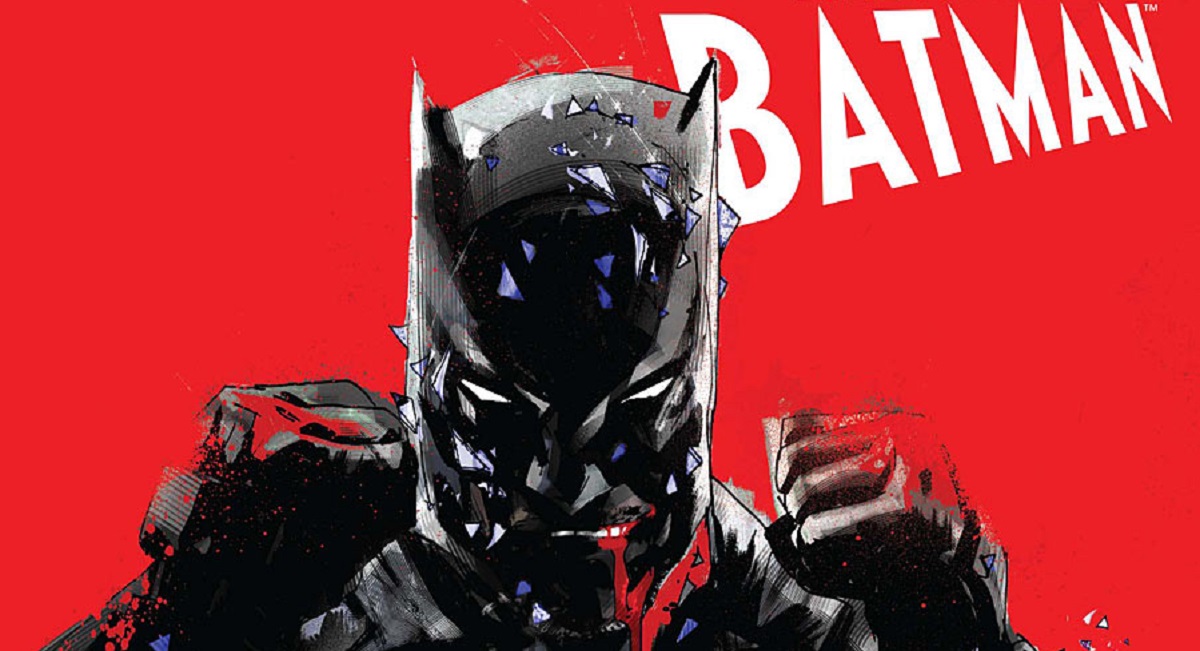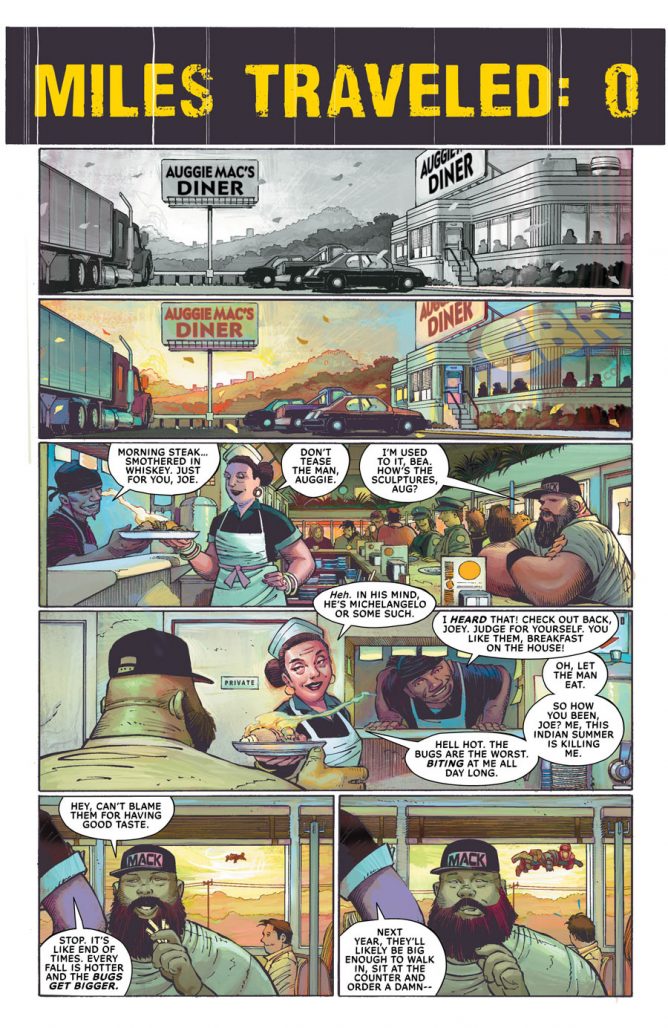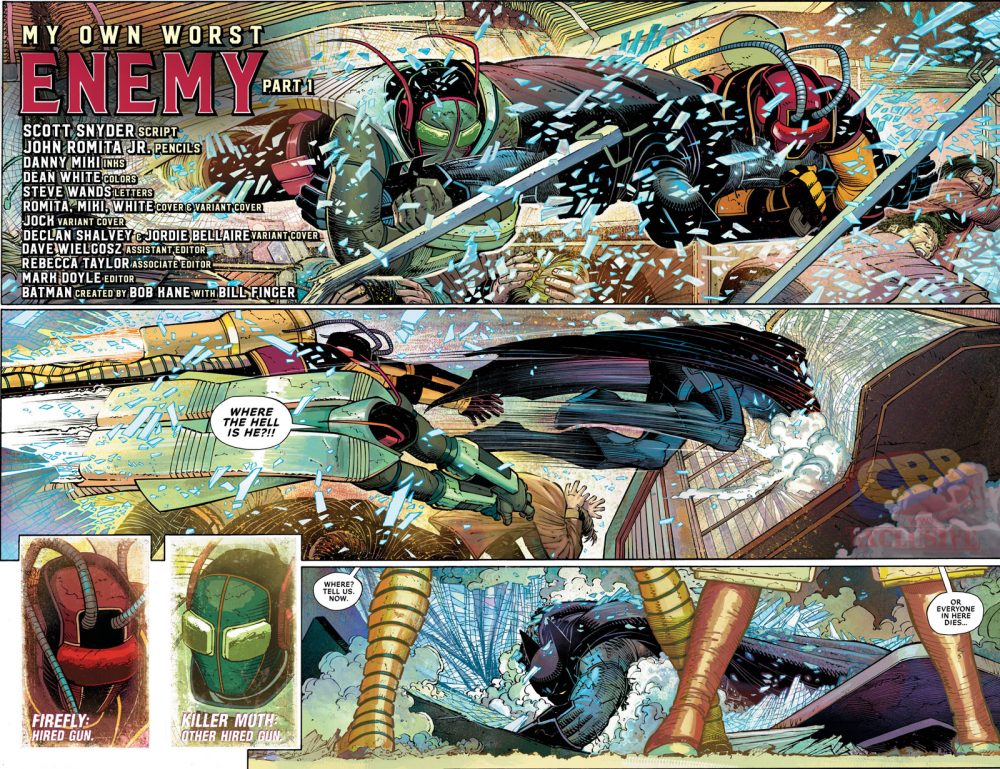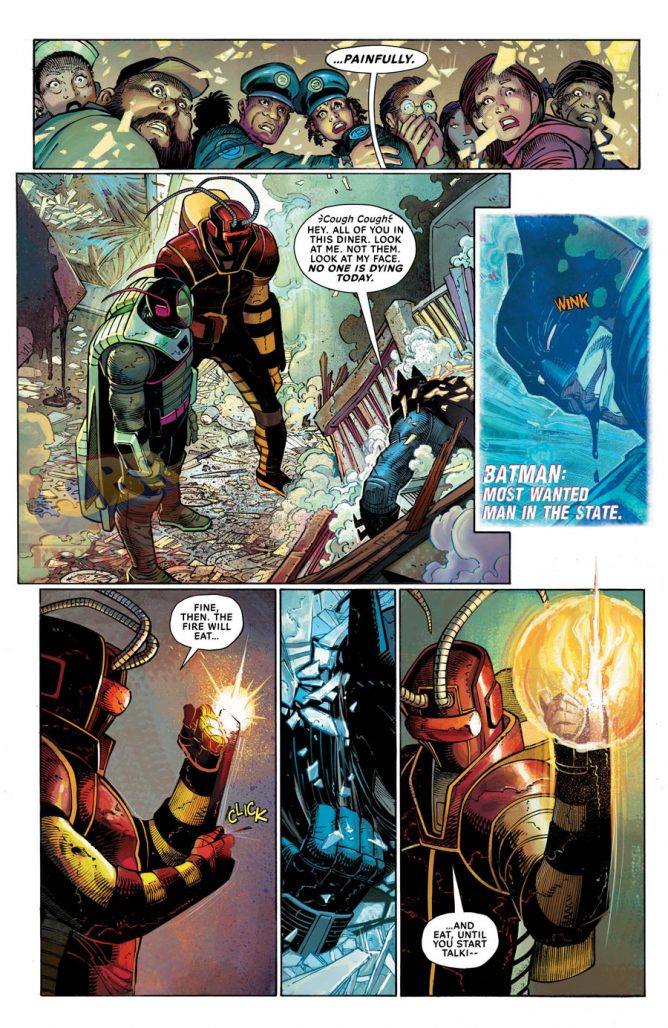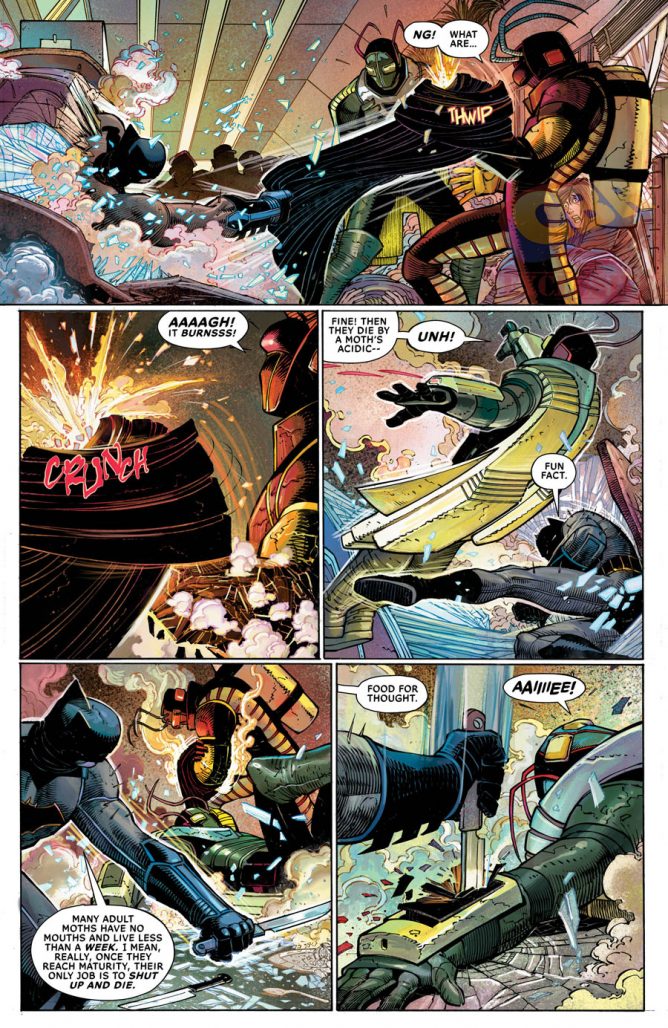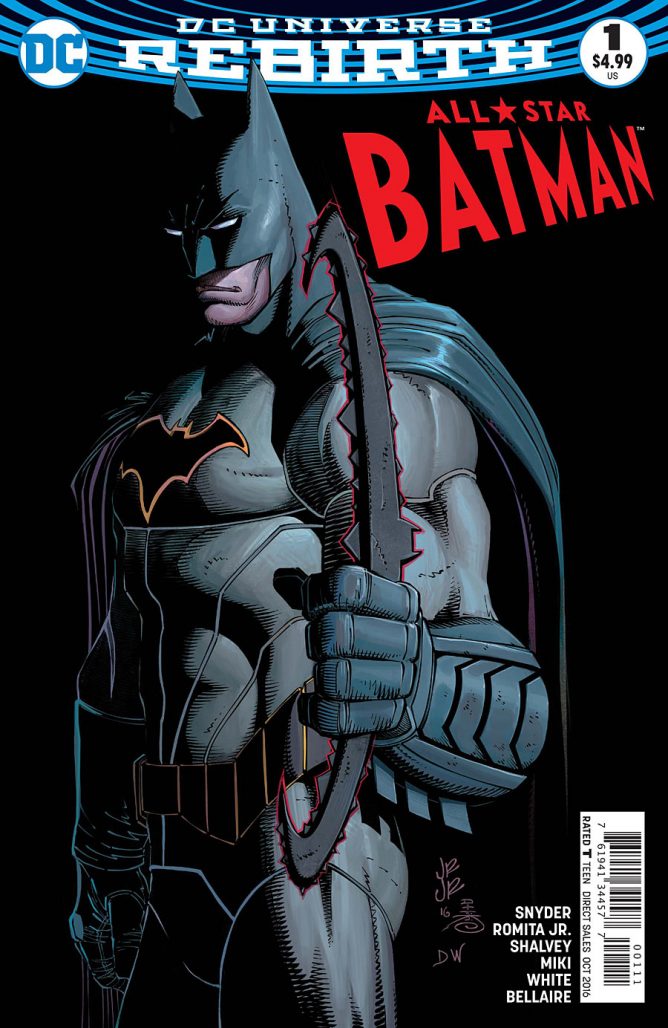
In All-Star Batman, Snyder aims to break all the rules. He has assembled a killer roster of artists including John Romita Jr., Paul Pope, and Tula Lotay to tell brand new stories about the Batman that force him outside of his element. The first issue of the new series, drawn by Romita Jr, sees Batman thrust out of the shadowy spires of Gotham and into the cold light of day as he escorts the villainous Two-Face to an unknown location. However, Two-Face isn’t making the journey an easy one. He’s put out an offer to all of Gotham—kill the Bat for a cash reward or see everyone’s deepest secrets revealed to the world.
The stakes have never been higher for Batman or for Snyder than they are now. In celebration of his work on Batman and the stories to come, Comics Beat editors Alex Lu and Kyle Pinion recently sat down with Snyder to discuss the origins of All-Star Batman in the first part of a new interview series about the title.
Alex Lu: What inspired the creation of All-Star Batman?
Scott Snyder: About a year before Greg Capullo and I got the sense that we were about to finish up on Batman, I really tried to do some soul searching. There’s a lot of pressure that comes with writing Batman. Some of it I loved, but there’s another part of that pressure that really didn’t do wonders for my mental health and my family life.
I’ve always had issues with anxiety and there’s this sort of grind that comes with needing to always carry a torch for the Bat line front and center. There’s a conflict between that and also trying to ignore it all to make a story you’re really invested in, proud of, and is important to you. You hope that the more pragmatic demands are baked into the DNA of your story simply because you liked them. That conflict was not something I felt like I would miss so I thought about leaving DC for a bit or even leaving superhero comics, but ultimately I realized that there were still a bunch of characters I really wanted to explore– the villains, especially. I realized I had been thinking a lot over the past years about, why someone like Mr. Freeze, Poison Ivy, or Two-Face is still scary to me today. I started to get this idea for a series where I’d do personal takes on the villains in a similar way to how Greg and I worked with The Joker and The Riddler in Batman.
However, I knew that if I was going to do it, I didn’t want a single artist on the series that would compete with Greg or get me to write the series in only one way. Greg and I would always try to challenge each other, to zig and zag from what we had previously done on Batman from arc to arc, but ultimately the whole series was a single conversation between me and Greg. With All-Star Batman, I wanted to artistically challenge myself the way I had been when I brought Becky Cloonan, Matteo Scalera, Jock, or Brian Azzarello on for an issue of Batman. That’s where I got the idea to do a series that would allow me to look at the Batman villains through a very prismatic approach. I wanted to work with artists like John Romita Jr., Sean Murphy, Paul Pope, Afua Richardson, and Jock. These are artists that I adore and am friends with, but might not come to mind immediately when you think of Batman, and that’s the beauty of it. When I work with each of them, we take a villain together and I tell them some of my ideas. They come back with theirs and then we come up with something we feel passionate about together. It’s a completely different way of working on Batman.
In addition, I didn’t want All-Star Batman to be redundant or duplicative when you look at it next to Tom King’s Batman. Tom has become a really close friend over the past couple of years, since he started working on Grayson, and I knew initially how terrific his take on Batman and Gotham would be. He’s the best writer this year in comics, I think, so I took Batman out of Gotham for All-Star Batman so Tom could do his thing. The challenge of taking Batman out of the city for every story was really exciting to me because it would allow me to explore the American landscape as well as American history and folklore in a similar way to how I like to do it in American Vampire and Wytches.
In sum, All-Star Batman became this project that I just couldn’t stop thinking about. It would have new takes on the Batman villains, new artists I hadn’t had the chance to work with on Batman, and we’d get to work on a Batman consistently outside of his familiar set pieces. I can’t wait to work with Greg again– we’re planning our sort of summer 2017 reunion right now actually with DC– but this series is just such a joy for other reasons. It feels like off-roading in the Batmobile, you know?
Lu: To zoom in on Romita, specifically– in previous interviews you discussed the format for All-Star Batman. At the time, you mentioned Romita would be working on the first five issues to complete Two-Face’s arc, but then the other artists would work on a series of oneshots. Is that still the case?
Snyder: Well, it’s going to be varied. He’s doing five issues with Declan and Jordie doing the back-up stories for the arc. Every issue after this arc wraps will have a back-up as well. After Romita finishes, Jock is doing Mr. Freeze with Francesco Francavilla in a sort of “Black Mirror” team reunion. That’s going to be one issue. Then Tula Lotay will work with me on a Poison Ivy story that will likely be two issues. Afua Richardson will follow up with a Catwoman story that will probably be one issue, but may end up being an oversized one given the way it’s developing right now.
At some point after that, Sean Murphy is going to do an arc that is the culmination of Duke’s story and also dovetails off all the All-Star stories that came before it. That’ll be 4 or 5 issues. Paul Pope will do a couple of issues following Sean and it looks like I will hopefully be doing a small 4 or 5 issue arc with Lee Bermejo.
I really feel like I could write this for a long, long time. I just love being tasked with doing a new take on a villain or villains with an artist I haven’t had a chance to work with in this particular format. Jock and Francesco are the only ones I’ve worked with extensively on Batman or on superhero comics in general. Again, it’s really a blast in that regard.
Lu: We’re really stretching off into the sunset here! Early on, there was indication that the series might run for 13 issues in total. Is that no longer the case?
Snyder: Oh no, that’s just the first year, basically. I didn’t want to harp on the fact that the first year is one story because I feel like people are so used to me doing these long arcs and All-Star isn’t designed that way at all. The first year of stories isn’t one arc, but the books go together as a sort of set with one line of thinking. Each arc is self-standing, but it all culminates in Sean’s story. There’s a subplot you might not catch in the first arc, but by the second and third you’ll start to see that this whole saga is about something. It asks “who is Batman’s worst enemy? Who is it that makes him most vulnerable and who is it that would be the scariest person to step out of the shadows and face him in a big way?” Not as a mastermind who’s “behind it all,” but as a culmination.
However, the series certainly doesn’t end after that first year. It really is ongoing. It’s not like Superman Unchained where we really only had one arc planned. As much as Jim Lee and I talked about going on with it at times, I think it was clear from really early on for him that his obligations to DC wouldn’t allow for that kind of thing.
Kyle Pinion: Scott, earlier you mentioned the anxiety you had while working on the main Batman title due to the need to balance your own creative desires with the needs of the line. When you started working on All-Star Batman, did you feel like you had a little bit more freedom to take the story everywhere you wanted it to go?
Snyder: Yeah, I did. When I was considering taking the project on, I received many opinions from all sides. I got a lot of push from friends who were at Marvel who said it might be a mistake not to come over there and that strategically it didn’t make sense to stay on Batman anyways. Then, I had friends at DC saying “you should stay on the main book and pull it out of double ship if you can.” There was a lot of thinking about “what do you do?”
Honestly, what it really came down to was that I always felt like Greg and I were Batman together– I didn’t feel comfortable staying on the main series without him. In addition, I wanted a place where I could go and work with tremendous freedom.
The thing is, this story, I hope it comes off, the first issue at least, as fun and kinetic and bombastic with all of those elements that make it something you want to return to for pleasure. However, the story is also deeply personal to me and is very much about this moment in time. It’s not overtly, potently, or acutely political, but it very much touches on an idea that also runs through After Death.
As a kid in New York, Batman loomed very large as a hero because in his best stories, he often faced things that were direct corollaries for the provincial problems and issues that terrified people living in the city at that time– things from gang violence to urban decay and institutionalized racism. Nowadays though, the things that people worry about in any major city are much more national and global issues– terrorism, gun violence, global warming, embedded forms of racism, and social injustice. These things seem insurmountable in some way and it’s exacerbated by the fact that we’re so connected to each other right now. All our cultures and economies overlap so our planet feels like a crowded elevator that’s heating up. There’s a sense of urgency that even when problems are happening overseas they’re getting closer and closer in proximity.
In this arc of All-Star, Two-Face says “the clown’s time came before when we were all getting used to the insanity of the world and the monstrousness of the problems we’re facing. Now we’re used to it and want to retreat from those problems and just get our needs met. We’re all secretly villains, not heroes. This makes this moment my moment because we’re becoming better and better at this kind of sociopathic impulse to show one face to the world, and another behind closed doors.”
Ultimately, working on All-Star Batman gives me tremendous freedom. It lets me experiment artistically and test out different structural forms of writing. It also lets me go deep and explore ideas that maybe are harder to narrativize in big, robust 11 issue arcs– although I am proud of what we were able to do in “Superheavy” and “Zero Year” as well. I just have even more elasticity here.
Pinion: Two-Face’s characterization really struck me as I read this first issue. His character traits have been extremely inflexible over the past 20-30 years. In my mind, his most defining stories are the Andy Helfer and Chris Sprouse Batman Annual #14, The Long Halloween, and the Bruce Timm animated series stories that feature him.
A character like the Joker changes constantly, but it feels like Harvey Dent has been trapped in amber over the past decade or two. How do you think your take on the character breaks that mold?
Snyder: The Chris Sprouse issue– that was one of my favorites– his history with his father… I did a lot of Two-Face research this past year, but you’re right, for me one of the challenges about the character is that there are sort of two templates that most Two-Face stories fall into. One of them usually revisits his origin and retells it in a new way or revisits it to sort of make him sympathetic to Bruce and really pulls the heartstrings about how he used to be Harvey Dent and how they used to be allies. Then the second one usually shows him cured and then returning to being Two-Face somehow, and there’s a hope of his face being repaired and that stuff. There are also a lot that fall in the middle, like Matt Wagner’s Faces, but for me it became about not reinventing him for the sake of reinventing him, but to approach him and say, “What do I find potent and scary about this character, given the things that I worry about for me and for my kids today?”
Here it really became about why Two-Face would be an endearing villain now. In general, he’s awesome; he flips the coin, he’s scary, he’s got this great aesthetic. However, what about him resonates? I kept coming back to this idea that we all have a coin we want to flip into the fountain and make a wish that we shouldn’t. He sees that desire with this kind of black and white or color blind eye. He sees who you are– the person that you don’t want to admit you are. Batman sees a lesser you without that villainous side but Two-Face says “we don’t want to be heroes. We want to be villains.”
I think there’s something particularly poignant about that now, when we’re such visible people, both in the way we have personas that precede us online and all of these things, but also even in a systemic way in that we’re always observed. There’s always a sense of being in public or presenting something of yourself to the world. I think the thing that he loves to revel in is the person that exists behind closed door, the side of your face you don’t want to show the mirror. That started to take on a real life of its own for me in terms of a set of ideas and themes in mind, both through him and then narratively in the story.
What makes Two-Face dark and scary is that there’s a kernel of truth to what he says. None of us are the people we like to present to the world.
Pinion: When I see this presentation of Harvey Dent as an information broker, the first thing I think of is Julian Assange, Edward Snowden, this new wave of internet revolutionaries that broker this information that really can change the world both positively and negatively. Did those real world figures draw into your characterization at all?
Snyder: Yeah, very much. The threat of being exposed looms really large for all of us. I was joking around the other day with Charles Soule, about how my browser search history essentially read: “how to dissolve a body” and “kids’ soccer game times.” These are the most damning searches and I can always say, “Oh, it’s because I’m a writer,” but the point is, regardless of whether you have a real reason to look things up or not, there’s a darker side to it too. These are the things that you think that you don’t want the person you love to know you think. There’s a threat of the real you being dragged out into the light which scares us because we’re all messy, ugly people in a lot of ways despite all of the redeeming qualities we have.
The other thing I love about Two-Face is that he doesn’t want to expose anybody. He loves that everyone has secrets. He wants the world to run this way all the time. He tries to make crime easier for people because he wants them to indulge themselves– he’s not even doing it to just make money. He deeply believes that this is how people are, and that the more opportunity they have to be selfish, the better off they are.
This story has this kind of urgent Road to Nowhere feel because Two-Face believes that soon people will reveal themselves to be wholly compromised and selfish. He only attacks the city when he finds the people inside it being hypocritical– when these crime bosses help Batman take Two-Face down, for example. In issue two, Two-Face says the people want to be punished and that even if Batman successfully gets them to where they’re going and all of Two-Face’s secrets come out, they won’t applaud Batman. He asks “Do you think you’re going to be the hero of this story? Because you’re not. They’re going to hate you.” Batman responds, “They’ll thank me in time,” but to Two-Face there is no time because it’s the end of times.
Lu: Throughout this issue, I was captivated by images of light. A great deal of this issue depicts Batman in open fields and the sun, leaving him physically exposed in the way Two-Face wants to expose Gotham’s true face. To twist the theme a bit, is Harvey trying to say that Batman’s ideals are a lie? That he makes the world a worse place for believing in the people’s fundamental goodness?
Snyder: Yeah. John and I discussed the aesthetic sensibility of the arc a ton before we started it. John lives right down the road, which is funny, and I didn’t realize he did until we started talking about working together. I literally run past his house all the time. So we go down into town and talk about it. But Danny Miki and Dean White are just incredible as well. I know everybody says they’re close when they’re on a team, but we really are very close and part of the feel that I was really looking to capture in All-Star Batman, and that they executed even better than I imagined, was a sense of Batman in the frontier– Batman in a landscape that mirrors the solitude of both his mission, his thinking, and the lack of shadows to hide in. There’s no gargoyle, no alley way, nowhere to disappear. You’re out there in the blazing sun, and it’s a reckoning. You’re also forced to see people that you’re not used to.
The other thing is that as a road trip story, All-Star Batman also takes Batman through everywhere he doesn’t see outside of Gotham. Towards the end, when we get closer to the climax, one set piece that I really love is this old riverboat casino that Harvey fought against as the D.A. and then supported as Two-Face. It’s in this town that went belly up so you see these places that are suffering while Gotham gets all of this funding. People out there say “Gotham is so special, but what about us out here? I want mine too.” And justifiably so. There’s a sense of the landscape I think being hostile to Batman, not just because it’s unfamiliar but because I think he’s insulated in Gotham. He doesn’t see the favoritism a city like Gotham gets: statewide, for federal funding– all of it.
Tune in on Thursday for the second half of our discussion on All-Star Batman #1! The book hits store shelves tomorrow.


